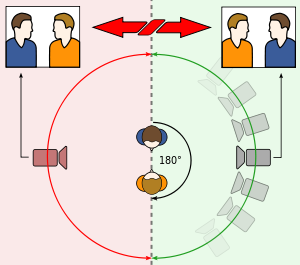User:Aekropp/sandbox

In film making, the 180-degree rule[1] is a basic guideline regarding the on-screen spatial relationship between a character and another character or object within a scene. An imaginary line called the axis connects the characters and by keeping the camera on one side of this axis for every shot in the scene, the first character will always be frame right of the second character, who is then always frame left of the first. If the camera passes over the axis, it is called jumping the line or crossing the line.
Example[edit]
In a dialogue scene between two characters, Justin (orange shirt, frame left in the diagram) and Drew (blue shirt, frame right), the camera may be placed anywhere on the green 180° arc and the spatial relationship between the two characters will be consistent from shot to shot, even when one of the characters is not on screen. Shifting to the other side of the characters on a cut, so that Drew is now on the left side and Justin is on the right, may disorient the audience.
Another example could be a car chase; if a vehicle leaves the right side of the frame in one shot, it should enter from the left side of the frame in the next shot. Leaving from the right and entering from the right will create a similar sense of disorientation as in the dialogue example.
Common Usage, Pitfalls and Solutions[edit]
Usage[edit]
The 180-degree rule enables the audience to visually connect with unseen movement happening around and behind the immediate subject and is important in the narration of battle scenes. The visual disjointedness of the battle scene on Geonosis in the Star Wars film Attack of the Clones is an example.[2]
Pitfalls[edit]
The imaginary line allows viewers to orient themselves with the position and direction of action in a scene. If a shot after the original shot in a sequence is located on the opposite side of the 180-degree line, then it is called a "reverse cut." Reverse cuts disorient the viewer by presenting an opposing viewpoint of the action in a scene and consequently altering the perspective of the action and the spatial orientation established in the original shot.[3]
Solutions[edit]
There are a variety of ways to avoid confusion related to crossing the line due to particular situations caused by actions or situations in a scene that would necessitate breaking the 180-degree line.
Prevention[edit]
Either alter the movement in a scene, or set up the cameras on one side of the scene so that all the shots will reflect the view from that side of the 180-degree line.[3]
Buffer Shot Usage[edit]
In order to minimize the "jolt" between shots in a sequence on either sides of the 180-degree line, shoot a "buffer shot" along the 180-degree line separating each side. This will allow the viewer to visually comprehend the change in viewpoint that is being expressed in the sequence.[3]
Style[edit]
This section possibly contains original research. (March 2013) |
In professional productions, the applied 180-degree rule is an essential element for a style of film editing called continuity editing. The rule is not always obeyed. Sometimes a filmmaker will purposely break the line of action in order to create disorientation. Stanley Kubrick was known to do this, an example being the bathroom scene in The Shining. The Wachowski Siblings and directors Tinto Brass, Yasujiro Ozu, Wong Kar-wai, and Jacques Tati sometimes ignored this rule also,[5] as has Lars von Trier in Antichrist.[6] In the seminal film of the French New Wave, À bout de souffle ("Breathless"), Jean-Luc Godard breaks the rule in the first five minutes in a car scene that jumps between the front and back seats, improvising an "aesthetic rebellion" for which the New Wave would become known.[7]
English television presenters Ant & Dec extend this continuity to almost all their appearances, with Ant almost always on the left and Dec on the right, as does the Japanese pop duo Puffy, with Yumi Yoshimura on the left and Ami Onuki on the right. The same follows with Irish twin brothers John and Edward Grimes, better known as Jedward, with John on the left and Edward on the right.
Another "rule" concerning the axis is that the closer a camera is placed to the axis, the more emotionally involved the audience will be.
In the Japanese animated picture Paprika, two of the main characters discuss crossing the line and demonstrate the disorienting effect of actually performing the action.
In Peter Jackson's The Lord of the Rings: The Two Towers, Gollum has a conversation with himself or with his other personality. Because the filmmakers use the 180-degree rule, and have the "good" Gollum looking left as he speaks while the "evil" Gollum looking right, the audience perceives Gollum as two different characters talking to each other. This effect builds gradually during the scene: the first few times Gollum shifts between personalities, he is shown starting to turn his head, though the camera changes angles mid-turn. As the argument between the split-personalities intensifies, the editing gradually changes to using jump cuts, not showing Gollum turning his head.
See also[edit]
References[edit]
- ^ Proferes, Nicholas T. (2005). Film Directing Fundamentals (2nd ed.). Amsterdam: Focal Press. pp. 5–7. ISBN 978-0-240-80562-7.
- ^ Nick Jamilla: Sword Fighting in the Star Wars Universe Jefferson, N.C.: McFarland Publishing, 2008. ISBN 978-0-7864-3461-9 pp. 213–14
- ^ a b c title=Help:Wiki_markup "Crossing The Line: Reverse Cut". MediaCollege.com.
{{cite web}}: Check|url=value (help); Missing pipe in:|url=(help) - ^ "Crossing the line/180-degree rule broken". Cinematography.com. Retrieved 24 August 2012.
- ^ www.solutioneers.net
- ^ www.religiondispatches.org "Mother (Nature) will Eat You: Lars Von Trier's Antichrist"
- ^ T. Jefferson Kline, "The French New Wave" in Elizabeth Ezra (ed.) European Cinema (Oxford: Oxford University Press, 2004)

